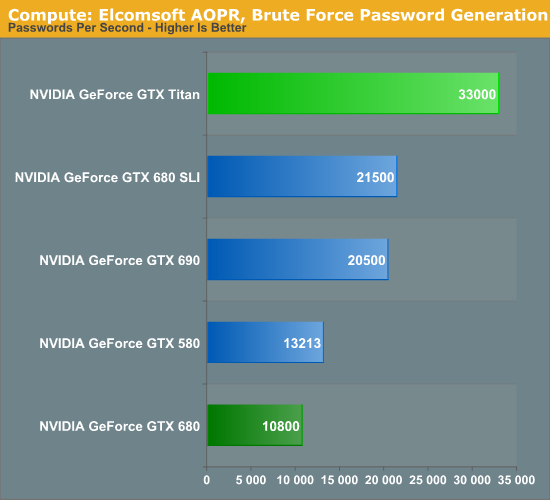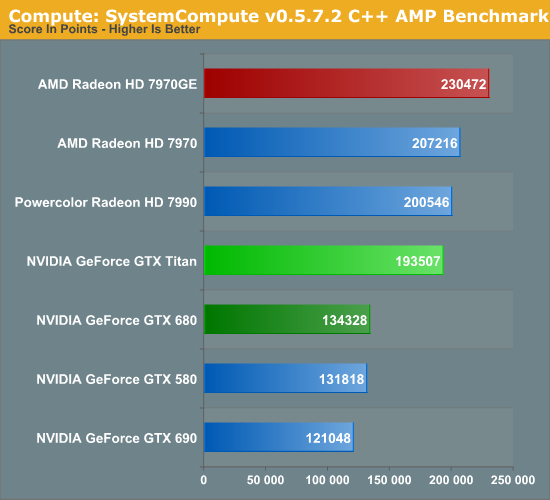NVIDIA’s GeForce GTX Titan Review, Part 2: Titan's Performance Unveiled
by Ryan Smith & Rahul Garg on February 21, 2013 9:00 AM ESTTitan’s Compute Performance, Cont
With Rahul having covered the basis of Titan’s strong compute performance, let’s shift gears a bit and take a look at real world usage.
On top of Rahul’s work with Titan, as part of our 2013 GPU benchmark suite we put together a larger number of compute benchmarks to try to cover real world usage, including the old standards of gaming usage (Civilization V) and ray tracing (LuxMark), along with several new tests. Unfortunately that got cut short when we discovered that OpenCL support is currently broken in the press drivers, which prevents us from using several of our tests. We still have our CUDA and DirectCompute benchmarks to look at, but a full look at Titan’s compute performance on our 2013 GPU benchmark suite will have to wait for another day.
For their part, NVIDIA of course already has OpenCL working on GK110 with Tesla. The issue is that somewhere between that and bringing up GK110 for Titan by integrating it into NVIDIA’s mainline GeForce drivers – specifically the new R314 branch – OpenCL support was broken. As a result we expect this will be fixed in short order, but it’s not something NVIDIA checked for ahead of the press launch of Titan, and it’s not something they could fix in time for today’s article.
Unfortunately this means that comparisons with Tahiti will be few and far between for now. Most significant cross-platform compute programs are OpenCL based rather than DirectCompute, so short of games and a couple other cases such as Ian’s C++ AMP benchmark, we don’t have too many cross-platform benchmarks to look at. With that out of the way, let’s dive into our condensed collection of compute benchmarks.
We’ll once more start with our DirectCompute game example, Civilization V, which uses DirectCompute to decompress textures on the fly. Civ V includes a sub-benchmark that exclusively tests the speed of their texture decompression algorithm by repeatedly decompressing the textures required for one of the game’s leader scenes. While DirectCompute is used in many games, this is one of the only games with a benchmark that can isolate the use of DirectCompute and its resulting performance.
Note that for 2013 we have changed the benchmark a bit, moving from using a single leader to using all of the leaders. As a result the reported numbers are higher, but they’re also not going to be comparable with this benchmark’s use from our 2012 datasets.

With Civilization V having launched in 2010, graphics cards have become significantly more powerful since then, far outpacing growth in the CPUs that feed them. As a result we’ve rather quickly drifted from being GPU bottlenecked to being CPU bottlenecked, as we see both in our Civ V game benchmarks and our DirectCompute benchmarks. For high-end GPUs the performance difference is rather minor; the gap between GTX 680 and Titan for example is 45fps, or just less than 10%. Still, it’s at least enough to get Titan past the 7970GE in this case.
Our second test is one of our new tests, utilizing Elcomsoft’s Advanced Office Password Recovery utility to take a look at GPU password generation. AOPR has separate CUDA and OpenCL kernels for NVIDIA and AMD cards respectively, which means it doesn’t follow the same code path on all GPUs but it is using an optimal path for each GPU it can handle. Unfortunately we’re having trouble getting it to recognize AMD 7900 series cards in this build, so we only have CUDA cards for the time being.

Password generation and other forms of brute force crypto is an area where the GTX 680 is particularly weak, thanks to the various compute aspects that have been stripped out in the name of efficiency. As a result it ends up below even the GTX 580 in these benchmarks, never mind AMD’s GCN cards. But with Titan/GK110 offering NVIDIA’s full compute performance, it rips through this task. In fact it more than doubles performance from both the GTX 680 and the GTX 580, indicating that the huge performance gains we’re seeing are coming from not just the additional function units, but from architectural optimizations and new instructions that improve overall efficiency and reduce the number of cycles needed to complete work on a password.
Altogether at 33K passwords/second Titan is not just faster than GTX 680, but it’s faster than GTX 690 and GTX 680 SLI, making this a test where one big GPU (and its full compute performance) is better than two smaller GPUs. It will be interesting to see where the 7970 GHz Edition and other Tahiti cards place in this test once we can get them up and running.
Our final test in our abbreviated compute benchmark suite is our very own Dr. Ian Cutress’s SystemCompute benchmark, which is a collection of several different fundamental compute algorithms. Rahul went into greater detail on this back in his look at Titan’s compute performance, but I wanted to go over it again quickly with the full lineup of cards we’ve tested.

Surprisingly, for all of its performance gains relative to GTX 680, Titan still falls notably behind the 7970GE here. Given Titan’s theoretical performance and the fundamental nature of this test we would have expected it to do better. But without additional cross-platform tests it’s hard to say whether this is something where AMD’s GCN architecture continues to shine over Kepler, or if perhaps it’s a weakness in NVIDIA’s current DirectCompute implementation for GK110. Time will tell on this one, but in the meantime this is the first solid sign that Tahiti may be more of a match for GK110 than it’s typically given credit for.










337 Comments
View All Comments
Sufo - Thursday, February 21, 2013 - link
lol, you clearly haven't run a dual gpu setup.Veteranv2 - Thursday, February 21, 2013 - link
Such a shame. How you can you disregard all the dual GPU cards?Another biased review. I miss the time when Anand used to be objective. Now it is just a Intel/Nvidia propaganda site. Not even an objective final thoughts. It is really a shame. I feel sad.
Ryan Smith - Thursday, February 21, 2013 - link
Um? They're there. Along with 680 SLI and 7970GE CrossFire.processinfo - Thursday, February 21, 2013 - link
Act surprised? He means that in final thoughts you downplaying fact that Titan is slower than dual GPU cards. I agree with him. It seems biased, especially when later you talk about 3 way SLI with Titan that would have same issues like dual GPU cards. They cost the same or less and they are faster. For gaming this card brings nothing to the table. For $500-600 it would be different story.Ryan Smith - Thursday, February 21, 2013 - link
Ahh.So our editorial stance is that while SLI/CF are great, they should only be used to increase performance beyond what a single large GPU can accomplish. AFR comes with some very notable penalties, and while these are acceptable when you can go no bigger, we do not believe these are good tradeoffs to make otherwise.
It's the same reason why we didn't recommend cards like the GTX 560 Ti 2Win over the GTX 580.
http://www.anandtech.com/show/5048/evgas-geforce-g...
Simply put we'd rather have the more consistent performance and freedom from profiles that having a single GTX Titan provides, over the higher but also more unreliable performance of a GTX 690.
Alucard291 - Thursday, February 21, 2013 - link
Well its exactly as you said Ryan. Its overpriced and badly positioned in the market (except you used much kinder words - presumably to keep your paycheck)Its a nice, pointless consumer (that's a key word right here) gpu which brings benefits (what are those benefits exactly?) of overpriced compute performance to people who don't need compute performance.
Beautiful move Nvidia.
processinfo - Thursday, February 21, 2013 - link
It is not about recommendation. I prefer single GPU and no SLI configs myself.It is about a fact that it is just slower than anything with similar price tag.
This is card only for people who need both: fast gaming card and computing card in one (or for those who don't care about a price).
Hrel - Thursday, February 21, 2013 - link
I think it's about time you re-asses that stance. SLI/CF has come a long way in the past few years.Also, 1000 dollars for one card puts it so far out of consideration it doesn't even count as an option for single GPU use. Which was why he said "For $500-600 it would be a different story". For gaming this card is useless. For Compute it seems 7970GHE would be a better option too. Again, based solely on price. Performance is close enough it makes WAY more sense to just buy 2 of those for 860 bucks if you really need to do some serious GPU compute.
Ryan Smith - Thursday, February 21, 2013 - link
Actually we did re-assess our stance ahead of this article.Far Cry 3 came out and SLI didn't work correctly; it took a few NVIDIA releases to get it up to where it is today. That's exactly the kind of scenario that drives our existing stance.
CeriseCogburn - Thursday, February 21, 2013 - link
Yes, of course, forget mentioning the half decade of AMD epic failure in CF...It's just amazing what I read here. The bias is so glaring a monkey couldn't miss it.